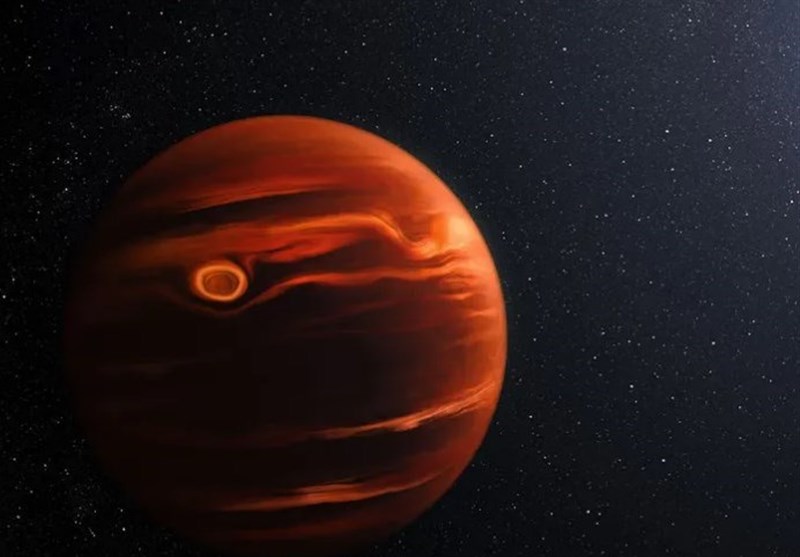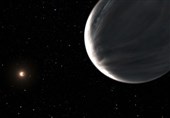Recently Found Exoplanet Has Atmospheric Sandstorms, Numerous Ingredients for Life
TEHRAN (Tasnim) – Using the James Webb Space Telescope, scientists have made a remarkable discovery about a unique planet located about 40 light years from Earth.
Unlike Earth, the exoplanet — named VHS 1256 b — takes approximately 10,000 years to orbit around its two host stars, and is located four times farther from its host stars than Pluto is from our Sun. An exoplanet is a planet that orbits a star that is not our sun. Until 1992, no exoplanets had ever been detected, as telescope technology was not powerful enough to resolve planets in other solar systems.
Despite orbiting at such a vast distance from its host stars, the James Webb Space Telescope was able to study VHS 1256 b's atmosphere and found evidence of several intriguing compounds — including water. Moreover, with just a few hours of observation time, the telescope was able to identify the largest number of molecules ever discovered on a planet outside our very own solar system. The observations indicated direct signatures of water, methane, and carbon monoxide, as well as evidence for carbon dioxide, all of which are chemical components that can be biosignatures indicative of life or the potential for life to form.
"There's a huge return on a very modest amount of telescope time," said co-author Beth Biller of the University of Edinburgh in the United Kingdom in a media statement. "With only a few hours of observations, we have what feels like unending potential for additional discoveries."
Using Webb's Near-Infrared Spectrograph and Mid-Infrared Instrument, scientists determined that this exoplanet has low gravity compared to other massive brown dwarfs. Scientists also found that the exoplanet has silicate clouds — meaning they are made out of sand — that were spotted higher in the exoplanet's atmosphere, where temperatures were as high as 1,526 degrees Fahrenheit (830 degrees Celsius).
"The finer silicate grains in its atmosphere may be more like tiny particles in smoke," Biller said. "The larger grains might be more like very hot, very small sand particles."
It is believed that smoke and dust particles hover above the exoplanet, as Biller mentioned. During its 22-hour day, the hotter material on top pushes colder material down, resulting in the most variable brightness changes known to occur on a planetary-mass object known to date.
"That means the planet's light is not mixed with light from its stars," science team lead Brittany Miles of the University of Arizona said.
Scientists have long anticipated that the powerful Webb Space Telescope would have an unparalleled ability to observe distant solar systems and their exoplanets. That includes its ability to probe for possible signs of life, such as water, oxygen or methane. The findings from this observation provide a potent example of the telescope's capabilities in this realm.
"No other telescope has identified so many features at once for a single target," said co-author Andrew Skemer of the University of California, Santa Cruz. "We're seeing a lot of molecules in a single spectrum from Webb that detail the planet's dynamic cloud and weather systems."
Even though the exoplanet has so many compounds that could hint it could support life, like water, astronomers like Avi Loeb say it's unlikely.
"Webb's observations of VHS 1256 b show clear signatures of water, methane and carbon monoxide, and provide evidence for carbon dioxide," Loeb, an astronomy professor at Harvard University, told Salon. "These chemical components would be compelling bio-signatures of life if molecular oxygen was also detected, but on their own they are not biosignatures."
Loeb pointed to the data showing that the exoplanet has silicate clouds.
"The atmosphere of VHS 1256 b is constantly rising, mixing, and moving during its 22-hour day, bringing hotter material up and pushing colder material down," Loeb said. "The Webb Telescope proved that the clouds of VHS 1256 b are made up of silicate particles."
Still, scientists believe they've barely scratched the surface in regards to studying this unique exoplanet.
"We've identified silicates, but a better understanding of which grain sizes and shapes match specific types of clouds is going to take a lot of additional work," Miles said. "This is not the final word on this planet — it is the beginning of a large-scale modeling effort to fit Webb's complex data."






